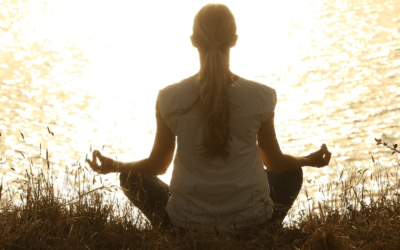 When our minds race and we can’t think straight and we’re generally not calm, we can easily obtain that calm through a combination of breathing and focusing our minds on calming images, especially those of nature.
When our minds race and we can’t think straight and we’re generally not calm, we can easily obtain that calm through a combination of breathing and focusing our minds on calming images, especially those of nature.
For instance, you can take your mind to where you are on your own, somewhere on a mountain, or at a river, or at a stream, or at a waterfall. Breathing calmly and casting our minds to such a quiet place brings about an inner calm.
Inner Calm To Regain Composure
By calming yourself, you’re able to regain composure and take your mind away from rushing around in a hectic lifestyle.
When your mind is calm, you’re able to see things more clearly.
An example: Sometimes when asleep, we awaken with a solution to some problem we might have been toying with. It is in the inner calm of our sleep that we create the solution.
We can also calm our minds when awake.
With this as some background, calm your mind while awake. Start by breathing deeply and steadying your breathing, and then visiting a quiet spot in nature.
Here we go.
- Take a deep breath, but inhale slowly and once inhaled, hold it there for two to three counts and exhale, slowly all the way.
- Now, push the last bit of air from your lungs and once exhaled, hold it there for two to three counts. And again, breathe in deeply and slowly to steady your breathing.
- Once inhaled, inhale the breath a little more, stretching your lungs and then holding it there for a count or two.
- Exhale slowly, again pushing the last bit of air from your lungs, then hold your breath after pushing out the last bit of air.
- Now slowly breathe in, filling your lungs to the point of stretching and expanding, and then hold the air for a moment or two.
- Exhale slowly. You might feel like coughing or become dizzy. This might be because you haven’t taken such deep breaths for a while. It’s okay to cough or become dizzy. In fact, there’s no right way of doing this and no wrong way either. You do it whichever way suits you.
- Keep to the rhythm of breathing in slowly and stretching your lungs to get a little more air into them. Hold it again for a moment or two, then exhale slowly and again gently push out the last bit of air, and then hold your breath for a moment or two once fully exhaled.
- Repeat this at least thirty times, preferably sitting up. Sitting might be better because you might fall asleep if you lie down when calming yourself, especially if you are tired or exhausted from other activities. In that case, you should instead do these calming exercises to rest. Once rested, you can again continue doing them to calm your mind as opposed to doing them to sleep.
- Next, focus on going to a quiet spot in nature while doing the breathing exercise. Observe whatever place in nature comes to mind. It doesn’t matter which spot. Don’t go looking for a spot; let the spot come to you.
- Once you see a spot in your mind, look at what you see. Look carefully and observe what the spot looks like. Don’t force your looking, just let your mind see what’s there. Take it all in.
- If you don’t see anything, just be quiet and relax and enjoy the inner calm. When you do this “quieting” or meditation exercise again later, you might experience a spot in your mind’s eye somewhere in nature where it is quiet and calm and peaceful and relaxing.
- If you do see a spot, take in what’s there, without forcing anything. Just enjoy the moment and let the quiet of your visit fill you and grow in you.
- While you’re there and taking it all in and observing your surroundings and yourself, stay there in this inner calm for a little while longer. You might become so calm and relaxed, you fall asleep. That’s fine; that’s the calm of the moment. Let it fill you, even to the extent that you fall asleep.
You can calm yourself or meditate often to train your usually frantic and restless mind to also experience calm and peacefulness. You can meditate as often as once a day, several times a day, or once a week or several times a week, or once a month or several times a month.
It doesn’t matter how often you meditate, as long as you meditate. There might come a time where you meditate very often. And there might come another time where you don’t meditate for months. You can meditate as and when it suits you. But if you don’t meditate at all, you will lose touch with the inner calm you experience when you are in the habit of meditating regularly.
You might want to play calming music while meditating. You can do this as often as you like. The important thing is that you meditate, always starting with the breathing and looking at whichever quiet spot in nature comes into your mind. The spot itself isn’t what is important. Oh, it might be. But the quiet spot has more to do with you focusing your mind away from the racing and frantic states we get ourselves into.
Meditate For Inner Calm
Your mind will grow accustomed to this inner calm, and when you aren’t calm, this is a good way of calming yourself—you can meditate as often as you like to calm yourself.
The important thing is to give your mind and emotions and physical body a rest, and the more you do it, the more you’ll like it. The calm and peaceful experience is also a very good indication of how busy your mind and emotions get. The contrast becomes apparent when you meditate. And until meditating here now, it’s even possible that this is the first time in a very long time, or possibly ever, that you calmed yourself.
The calm and peacefulness we gain from meditation is an indication of the state we’d prefer our mind and emotions and body to experience. It is also an indication of the state we usually find ourselves in: You’ll notice it from the contrast between when you’re quiet and when you’re not.
So go on; let’s create an inner calm regularly.
How David Works – Meditation, Grass is a longer meditation, enjoy!
In the video below, In How to Meditate, Lavendaire states: Meditation is a practice that can benefit your health and wellness in so many ways. I’ve been trying to meditate more lately, so I was inspired to make a basic how to meditate video focusing on creating beautiful visuals and experimenting with ways I can improve my craft.








